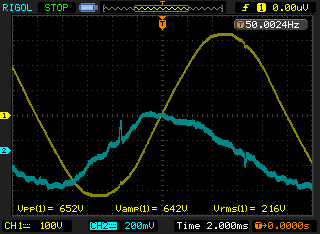playfsx, from your second video demonstration of the noise problem, and from the
walking spikes parts of it in particular, it seems that the mains line trigger circuitry of your scope is not responsible for the depicted interference, as
I initially suspected.
Now, here is an interesting waveform I captured, using my 100 MHz DS1052E:

Ch1 to the mains line; Ch2 floating
Channel 1 was reading the mains voltage directly
1, using a 100x probe, and
Channel 2 was reading whatever it could pick up while unconnected, using the standard 10x probe, floating.
Please note that it made no difference at all turning ON or OFF the 75W monitor (a DELL U2410) right in front of me, or the 250W halogen roof lamp (driven by a traditional and noisy phase-control TRIAC dimmer), or the 1.3KW room air-conditioning unit (the thermometer outside my window now reads 37 deg.C!). The captured waveforms were exactly the same, either the noisy units above were powered on or off.
For those who will notice it, the mains voltage was externally measured to be 228.7 VAC RMS, while the DS1052E measured it to be 218 VAC RMS (DS1052E error: -4.7% or -3bit); in defence of the DS1052E, I will have to state that I did not warm it properly up before taking these readings, neither have I recently run auto-calibration
2.
The interesting parts in the captured waveform above are the time points -1.7div (-3.4 ms) and +3.3div (+6.6 ms), where Ch1 captures a couple of seemingly innocuous mains disturbances, which are absolutely synchronised to the Ch2 obvious spikes. The problem is that, though the Ch1 and Ch2 waveforms are out of synch by ~1.4div (~2.8 ms), the Ch1 and Ch2 spikes are in perfect synchronisation.
Channel crosstalk, do I hear some of you murmuring? Well, maybe. But, by disconnecting the Ch2 probe, the second trace became a nice and clean flat line while the spikes at the first trace remained as they were exactly, and of the same shape and amplitude. So, I suppose that my scope is not really lying to me...
This means that:
1. The depicted spikes are probably generated erroneously within the oscilloscope front-end amplifiers.
2. Our mains lines are actually that dirty.
3. We are both being bombarded by who-knows-what kind of electromagnetic weapons

(I am kidding!).
What I can only say is that, in order to trust what my DS1052E tells me about my mains line spikes, I would have to repeat those readings with a higher class oscilloscope and not with another entry-level one.
-George
EDIT:1. DO NEVER TRY doing that if you are not absolutely sure of what you are doing, because the probe ground clip is the instrument's ground, which is hardwired to the mains power supply ground! Be very careful when messing with the mains line.
2. More than half an hour later, the mains line was reported by the DS1052E to be 221 VAC RMS, while it was measured to be 223.2 VAC RMS.